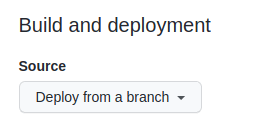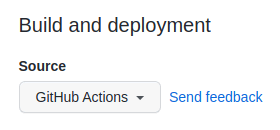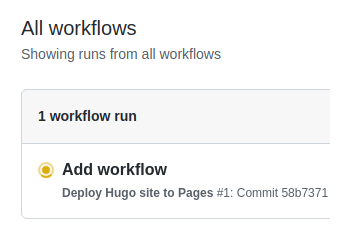Procedure Link to heading
Step 1 - Create a GitHub repository Link to heading
- I created this repository via GitHub website.
- Name:
Blog
Step 2 - Push your local repository to GitHub Link to heading
- We need to initiliaze git for remote repository:
git remote add origin https://github.com/ArmBraker/Blog.git
- Push the Code to GitHub
git branch -M main
git push -u origin main
Step 3 Link to heading
- Visit your GitHub repository. From the main menu choose Settings > Pages. In the center of your screen you will see this:

Step 4 Link to heading
- Change the Source to
GitHub Actions. The change is immediate; you do not have to press a Save button.

Step 5 Link to heading
Create a file named hugo.yaml in a directory named .github/workflows.
mkdir .github/workflows
Directory: C:\Users\<reduced>\Coding\_Blog\blog\.github
Mode LastWriteTime Length Name
---- ------------- ------ ----
d----- 1/18/2025 5:16 PM workflows
Step 6 Link to heading
Copy and paste the YAML below into the file you created. Change the branch name and Hugo version as needed.
# Sample workflow for building and deploying a Hugo site to GitHub Pages
name: Deploy Hugo site to Pages
on:
# Runs on pushes targeting the default branch
push:
branches:
- main
# Allows you to run this workflow manually from the Actions tab
workflow_dispatch:
# Sets permissions of the GITHUB_TOKEN to allow deployment to GitHub Pages
permissions:
contents: read
pages: write
id-token: write
# Allow only one concurrent deployment, skipping runs queued between the run in-progress and latest queued.
# However, do NOT cancel in-progress runs as we want to allow these production deployments to complete.
concurrency:
group: "pages"
cancel-in-progress: false
# Default to bash
defaults:
run:
shell: bash
jobs:
# Build job
build:
runs-on: ubuntu-latest
env:
HUGO_VERSION: 0.141.0
steps:
- name: Install Hugo CLI
run: |
wget -O ${{ runner.temp }}/hugo.deb https://github.com/gohugoio/hugo/releases/download/v${HUGO_VERSION}/hugo_extended_${HUGO_VERSION}_linux-amd64.deb \
&& sudo dpkg -i ${{ runner.temp }}/hugo.deb
- name: Install Dart Sass
run: sudo snap install dart-sass
- name: Checkout
uses: actions/checkout@v4
with:
submodules: recursive
fetch-depth: 0
- name: Setup Pages
id: pages
uses: actions/configure-pages@v5
- name: Install Node.js dependencies
run: "[[ -f package-lock.json || -f npm-shrinkwrap.json ]] && npm ci || true"
- name: Build with Hugo
env:
HUGO_CACHEDIR: ${{ runner.temp }}/hugo_cache
HUGO_ENVIRONMENT: production
TZ: America/Los_Angeles
run: |
hugo \
--gc \
--minify \
--baseURL "${{ steps.pages.outputs.base_url }}/"
- name: Upload artifact
uses: actions/upload-pages-artifact@v3
with:
path: ./public
# Deployment job
deploy:
environment:
name: github-pages
url: ${{ steps.deployment.outputs.page_url }}
runs-on: ubuntu-latest
needs: build
steps:
- name: Deploy to GitHub Pages
id: deployment
uses: actions/deploy-pages@v4
Step 7 Link to heading
Commit and push the change to your GitHub repository.
git add -A
git commit -m "Create hugo.yaml"
git push
Step 8 Link to heading
From GitHub’s main menu, choose Actions. You will see something like this:

Step 9 Link to heading
When GitHub has finished building and deploying your site, the color of the status indicator will change to green.
